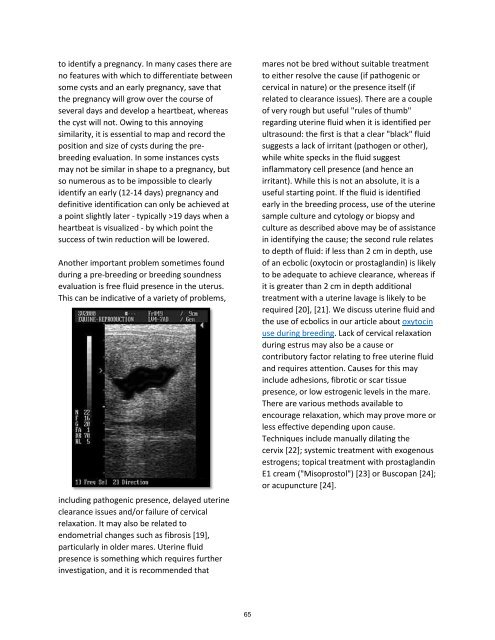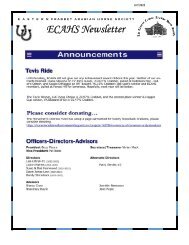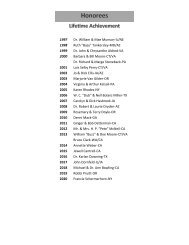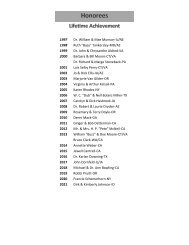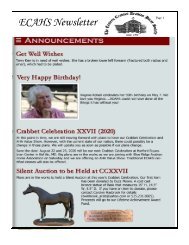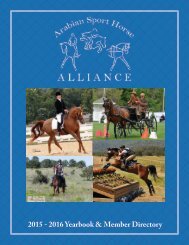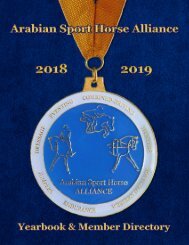Arabian Sport Horse Alliance 2017-2018 Directory & Yearbook
Annual publication of the Arabian Sport Horse Alliance, Inc. Honoree Articles, Award Listings, Photo Galleries, Youth Member Spotlights, Stallion Pages, Farm Profiles, Educational Articles, and more.....
Annual publication of the Arabian Sport Horse Alliance, Inc.
Honoree Articles, Award Listings, Photo Galleries, Youth Member Spotlights, Stallion Pages, Farm Profiles, Educational Articles, and more.....
You also want an ePaper? Increase the reach of your titles
YUMPU automatically turns print PDFs into web optimized ePapers that Google loves.
to identify a pregnancy. In many cases there are<br />
no features with which to differentiate between<br />
some cysts and an early pregnancy, save that<br />
the pregnancy will grow over the course of<br />
several days and develop a heartbeat, whereas<br />
the cyst will not. Owing to this annoying<br />
similarity, it is essential to map and record the<br />
position and size of cysts during the prebreeding<br />
evaluation. In some instances cysts<br />
may not be similar in shape to a pregnancy, but<br />
so numerous as to be impossible to clearly<br />
identify an early (12-14 days) pregnancy and<br />
definitive identification can only be achieved at<br />
a point slightly later - typically >19 days when a<br />
heartbeat is visualized - by which point the<br />
success of twin reduction will be lowered.<br />
Another important problem sometimes found<br />
during a pre-breeding or breeding soundness<br />
evaluation is free fluid presence in the uterus.<br />
This can be indicative of a variety of problems,<br />
including pathogenic presence, delayed uterine<br />
clearance issues and/or failure of cervical<br />
relaxation. It may also be related to<br />
endometrial changes such as fibrosis [19],<br />
particularly in older mares. Uterine fluid<br />
presence is something which requires further<br />
investigation, and it is recommended that<br />
mares not be bred without suitable treatment<br />
to either resolve the cause (if pathogenic or<br />
cervical in nature) or the presence itself (if<br />
related to clearance issues). There are a couple<br />
of very rough but useful "rules of thumb"<br />
regarding uterine fluid when it is identified per<br />
ultrasound: the first is that a clear "black" fluid<br />
suggests a lack of irritant (pathogen or other),<br />
while white specks in the fluid suggest<br />
inflammatory cell presence (and hence an<br />
irritant). While this is not an absolute, it is a<br />
useful starting point. If the fluid is identified<br />
early in the breeding process, use of the uterine<br />
sample culture and cytology or biopsy and<br />
culture as described above may be of assistance<br />
in identifying the cause; the second rule relates<br />
to depth of fluid: if less than 2 cm in depth, use<br />
of an ecbolic (oxytocin or prostaglandin) is likely<br />
to be adequate to achieve clearance, whereas if<br />
it is greater than 2 cm in depth additional<br />
treatment with a uterine lavage is likely to be<br />
required [20], [21]. We discuss uterine fluid and<br />
the use of ecbolics in our article about oxytocin<br />
use during breeding. Lack of cervical relaxation<br />
during estrus may also be a cause or<br />
contributory factor relating to free uterine fluid<br />
and requires attention. Causes for this may<br />
include adhesions, fibrotic or scar tissue<br />
presence, or low estrogenic levels in the mare.<br />
There are various methods available to<br />
encourage relaxation, which may prove more or<br />
less effective depending upon cause.<br />
Techniques include manually dilating the<br />
cervix [22]; systemic treatment with exogenous<br />
estrogens; topical treatment with prostaglandin<br />
E1 cream ("Misoprostol") [23] or Buscopan [24];<br />
or acupuncture [24].<br />
65


